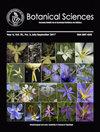Efecto del cambio climático en la distribución de las especies de clima templado en Oaxaca, México
IF 0.7
4区 生物学
Q3 PLANT SCIENCES
引用次数: 0
Abstract
Background: Climate change is becoming more evident, and distribution models are useful tools to predict the effect it might cause on biodiversity. Hypotheses: Under climate change scenarios, temperate forests species of the genus Pinus and Quercus will undergo reductions in their distribution area and changes in their spatial pattern. Studied species: Arbutus xalapensis, Clethra mexicana, Pinus devoniana, Pinus oocarpa, Pinus teocote, Quercus acutifolia, Quercus castanea, Quercus crassifolia, Quercus elliptica, Quercus magnoliifolia and Quercus rugosa. Study site: Oaxaca Methods: Two scenarios were constructed, an optimistic one (SSP-1 and RCP 2-6) and a pessimistic one (SSP-5 and RCP 8.5) for the years 2030 and 2090. A total of 1,383 records and eight bioclimatic variables were used, along with seven learning algorithms, evaluated using ROC and TSS metrics. Results: An ensemble model was obtained, in which the most important contributing variables were precipitation of the wettest quarter, mean annual temperature, minimum temperature of the coldest month and annual temperature range. The species that showed the highest ROC values were Clethra mexicana (0.91) and Arbutus xalapensis (0.89) with TSS values of 0.68 and 0.60, respectively. Conclusions: Regardless of the scenario, by the year 2090 all species of Pinus and Quercus will reduce their potential distribution. Therefore, it is urgent to establish conservation policies.气候变化对墨西哥瓦哈卡温带气候物种分布的影响
背景:气候变化正变得越来越明显,分布模型是预测其可能对生物多样性造成的影响的有用工具。假设:在气候变化情景下,温带森林树种松、栎的分布面积将减少,空间格局将发生变化。研究树种:阿拉伯文杨梅、墨西哥油松、泥盆松、黄松、山地松、针叶栎树、板栗栎树、粗叶栎树、椭圆栎树、厚朴栎树和黑栎树。方法:构建了2030年和2090年的乐观情景(SSP-1和RCP 2-6)和悲观情景(SSP-5和RCP 8.5)。总共使用了1383条记录和8个生物气候变量,以及7种学习算法,使用ROC和TSS指标进行评估。结果:建立了以最湿季降水量、年平均气温、最冷月最低气温和年温差为主要影响因子的整体模型。ROC值最高的种为墨西哥草(0.91)和阿拉伯文杨梅(0.89),TSS值分别为0.68和0.60。结论:无论如何,到2090年,所有种类的松和栎的潜在分布都将减少。因此,制定保护政策迫在眉睫。
本文章由计算机程序翻译,如有差异,请以英文原文为准。
求助全文
约1分钟内获得全文
求助全文
来源期刊

Botanical Sciences
Agricultural and Biological Sciences-Plant Science
CiteScore
1.90
自引率
21.40%
发文量
71
审稿时长
16 weeks
期刊介绍:
Botanical Sciences welcomes contributions that present original, previously unpublished results in Botany, including disciplines such as ecology and evolution, structure and function, systematics and taxonomy, in addition to other areas related to the study of plants. Research reviews are also accepted if they summarize recent advances in a subject, discipline, area, or developmental trend of botany; these should include an analytical, critical, and interpretative approach to a specific topic. Acceptance for reviews will be evaluated first by the Review Editor. Opinion Notes and Book Reviews are also published as long as a relevant contribution in the study of Botany is explained and supported.
 求助内容:
求助内容: 应助结果提醒方式:
应助结果提醒方式:


